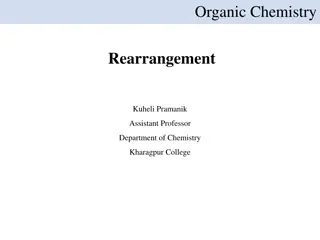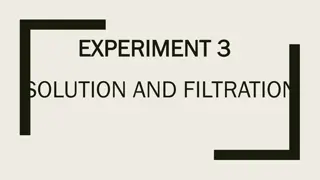Understanding Organic Chemistry Reactions: Electrophilic Addition, Stereochemistry, and Neighbouring Group Participation
In organic chemistry, different types of reactions play a crucial role in modifying compound structures. Electrophilic addition involves breaking bonds to form new ones, stereo specific reactions yield specific stereoisomers, and nucleophilic addition reactions break bonds by reacting with nucleophiles. Neighbouring group participation influences stereochemistry by retaining configuration during substitutions. These concepts are essential for understanding reaction mechanisms in organic chemistry.
Uploaded on Sep 30, 2024 | 0 Views
Download Presentation

Please find below an Image/Link to download the presentation.
The content on the website is provided AS IS for your information and personal use only. It may not be sold, licensed, or shared on other websites without obtaining consent from the author. Download presentation by click this link. If you encounter any issues during the download, it is possible that the publisher has removed the file from their server.
E N D
Presentation Transcript
CHEMISTRY.. Question & Answers By. Kavi
1 . What is Electrophilic Addtion In organic chemistry, an electrophilic addition reaction is an addition reaction where a chemical compound containing a double or triple bond has a bond broken, with the formation of two new bonds Eg. Hydrogen chloride adds to ethene to make chloroethane
2 . What is stereo specific and stereo selective reactions A stereo specific reaction is one which, when carried out with stereo isomeric starting materials, gives a product from one reactant that is a stereoisomer of the product from the other. 'Stereo specific' relates to the mechanism of a reaction, the best-known example being the SN2 reaction, which always proceeds with inversion of stereochemistry at the reacting centre.
A stereo selective process is one in which one stereoisomer predominates over another when two or more may be formed. If the products are Enantiomers , the reaction is enantio selective; if they are diastereo isomers, the reaction is diastereo selective. Stereo selectivity is dominated by the structural features of the reactants.
3 . What is necleophilic addition and examples In organic chemistry, a nucleophilic addition reaction is an addition reaction where a chemical compound with an electro philic double or triple bond reacts with a nucleophile, such that the double or triple bond is broken. Eg. Addition of water and acetic acid to acetylene are examples of nucleophilic addition reactions. Eg.
4 . What Is Neighbouring Group Participation A group which is attached to the carbon atom , adjacent to the carbon, where nucleophilic substitution is taking place, may become bonded or portially bonded on the reaction centre to form a non-classical or bridged carbonium ion such a participation is called the neighbouring group partipation 5 . Give the stereochemistry of neighbouring group participation of the product . In neighbouring group participation over all stereo chemical change results in retention of configuration , since double inversion occurs
When neighboring group participation is in operation it is normal for the reaction rate to be increased . It is also possible for the stereochemistry of the reaction to be abnormal when compared with a normal reaction . * chloro-ethyl sulphide
6 . In the reaction of Hydroxylation of epoxide in cyclohexene compound Ring opening of cyclohexene epoxide (I) yields a glycol, having two hydroxyl group diaxial rather then diequatorial. H2O
7 . Give any one proof for the formation of cyclic bromonium ion in bromination reaction # Exclusive formation of trans product proves the formation of cyclic bromonium ion # Attack of bromide ion on this intermediate can only occur form the opposite side , resulting in the exclusive formation of trans addition product # cis butene on bromination given d/l 2,3- dibromo butane and trans butene on bromination in mezo form. 8 . What is markownikoff rule Negative part of addendum will go and combaind with least hydrogenated carbon atom in addition reaction .
Eg. - 9 . Give the catalysts for the following reactions I. hydration of alkenes II. hydroxylation Hydration of alkenes catalyst -H2SO4 Hydroxylation catalyst - Osmium tetroxide (OsO4) and alkaline KmnO4
10 . Give the stereo chemistry of the following reactions Hydroboration - cis addition Haloganation - trans addition Hydroxilation through epoxylation trans addition, in the case of cyclohexene epoxide diaxial addition
11 . Define michael addition Michael reaction (Michael addition): The conjugate addition of a carbanion, enolate, enamine, or other carbon nucleophile to the -carbon of an enone, enol, or other , - unsaturated compound. This results in a new carbon-carbon bond at the -carbon. The Michael reaction nucleophile is called the Michael donor. 12 . Give any 2 applications of michael addtion The Michael addition method with high efficiency, simplicity and greenness has been the goal pursued by organic chemists. Herein
13 . Define 1,3-dipolar addition 1,3 dipolar addition is an addition between a organic azide and an alkyne to genarate 1,2,3-triazole. Diazo alkanes , azyl azide , osazone , azo oxy compound that undergo 1,3 dipolar addition Addition of a 1,3-dipolar compound to a double bond to form 5-membered hetero cyclic compound . This type of addition may be regarded as [2+3] cyclo addition .
14 . Give any 2 compounds that undergo micheal addition Classical examples of the Michael reaction are the reaction between diethyl malonate (Michael donor) and diethyl fumarate (Michael acceptor), that of mesityl oxide and diethyl malonate, that of diethyl malonate and methyl crotonate, that of 2-nitropropane and methyl acrylatethat of ethyl phenylcyanoacetate and acrylonitrile and that of nitropropane and methyl vinyl ketone. Malonic ester , unsaturated aldehyde , ketone , ester Ethyl eyanoacetate and ethylacetate 15 . What is simon smith reagent Di-iodo methane in the presence of zinc copper coupling ( Zn-Cu ) ,is simon smith reagent.
16 . Explain: anchimeric assistants in the acetolysis of cis and trans proxides Helogen atoms can form cyclic ions to offer anchimeric assistance in the acetolysis of cis & trans -2- helogeno cyclohexyl - brosylatco (1&2)
18. Identify the product of the following reactions (i) Tri propyl borane (ii)
20.Complete the following reactions (i) (II)























